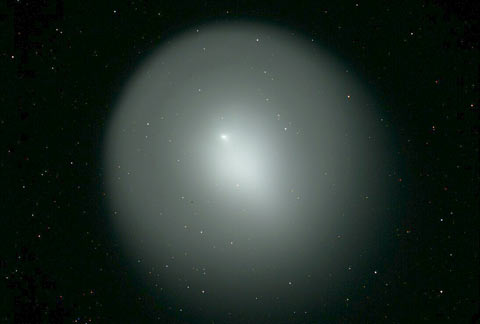Keck Telescope Captures Explosive Comet
By
Westmont
 Westmont’s Keck Telescope has provided color photographs of a rare celestial surprise in the northeastern evening sky. Comet 17P/Holmes in the constellation Perseus caught astronomers off guard when it suddenly brightened on October 24.
Westmont’s Keck Telescope has provided color photographs of a rare celestial surprise in the northeastern evening sky. Comet 17P/Holmes in the constellation Perseus caught astronomers off guard when it suddenly brightened on October 24.
“The comet was discovered by a British astronomer in the 19th century. Until several weeks ago it was nothing but an extremely faint object. Then, unexpectedly, its brightness increased about one million-fold,” says Michael Sommermann, Westmont professor of physics. “When looking at the comet’s coma, it’s larger now than any object in our solar system aside from the sun and easily visible to the naked eye.”
Experts speculate about the cause of the comet’s explosive brightening. Possible scenarios include a meteoroid hit, the rupture of a gas-filled cavity, and the partial breakup of the comet’s nucleus.
Scientists aren’t sure how long the comet’s show will last but estimate it could be weeks if not months. The comet should be in full view at the next public viewing at Westmont’s Carroll Observatory on Friday, November 16.
The Keck Telescope, a 24-inch F/8 Cassegrain reflecting instrument with Ritchey-Chretien optics, is one of the most powerful on California’s Central Coast. The images were captured with a CCD camera from Santa Barbara Instrument Group.
Westmont serves as one of the observing sites for the Santa Barbara Astronomical Unit (S.B.A.U.). Every third Friday of the month, the S.B.A.U. holds public viewings at the observatory.
Click here to view more space images taken by Westmont's Keck Telescope.
Filed under
Campus News